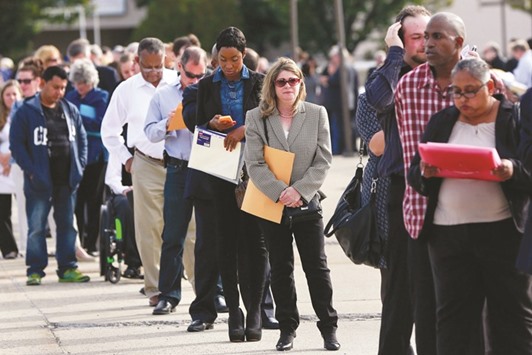The US economy expanded more in the second quarter than previously estimated, reflecting a smaller drag from business spending on structures and equipment.
Gross domestic product rose at a 1.4% annualised rate, compared with a prior estimate of 1.1%, Commerce Department figures showed yesterday. Gross domestic income, which reflects all the money earned by consumers, businesses and government agencies, was revised to show a 0.2% drop rather than a gain.
Households are doing the heavy lifting for the economy, making up for tepid business investment and lacklustre demand from overseas. On the heels of robust hiring and nascent wage gains, consumer spending is projected again to drive growth in the third quarter.
“It’s clearly been enough to carry us through,” Scott Brown, St Petersburg, Florida-based chief economist for Raymond James Financial Inc, said about household spending. “The US economy is generally in good shape” for the second half while “conditions around the rest of the world are still sluggish.”
Household consumption, which accounts for about 70% of the economy, was revised to 4.3% from a prior estimate of 4.4%.
The upward revision to GDP also reflected a smaller drag from inventories and higher exports.
The median forecast in a Bloomberg survey called for a 1.3% gain in GDP. Economists’ estimates for the value of all goods and services produced ranged from 0.9% to 1.7%.
The latest estimate is the last of three for the quarter before annual revisions next year. The economy grew at a 0.8% pace from January through March.
Investment in nonresidential structures, including office buildings and factories, fell at a 2.1% rate, rather than a previously reported 8.4% drop. Spending on equipment fell at a 2.9% pace, compared with 3.7% in the prior report.
Combined with a 9% increase in intellectual property products, non-residential fixed investment advanced at a 1% annualised pace in the second quarter. It was previously reported as falling 0.9%.
Final sales to private domestic purchasers rose at a 3.2% rate in the April through June period, revised from a previously reported 3% pace. The category reflects consumer and business spending and excludes government purchases, exports and inventories.
The decline in gross domestic income compares with a prior estimate of a 0.2% gain and was due to a downward revision to state and local tax receipts as well as collections from oil and gas producers.
Meanwhile, the number of applications to collect jobless benefits rose less than forecast last week, indicating employers are leery of dismissing workers as the labor market tightens.
Jobless claims rose by 3,000 to 254,000 in the week ended September 24 from a five-month low in the previous period, a Labour Department report showed yesterday. The median forecast in a Bloomberg survey called for 260,000. The number of Americans already on benefit rolls declined to the lowest level since 2000.
Dismissals have been hovering just above the lowest level since the 1970s as employers compete for experienced workers amid a record number of job openings. The data are consistent with the Federal Reserve’s view that the job market “has continued to strengthen” and employment gains have been “solid.”
Estimates in the Bloomberg survey ranged from 250,000 to 275,000. The Labour Department revised the prior week’s reading to 251,000 from an initially reported 252,000. In April, claims dropped to 248,000, the fewest since 1973.
Applications filed with state employment agencies have been below 300,000 for 82 straight weeks - the longest streak since 1970 and a level economists say is typical for a vibrant labour market. No states were estimated last week and there was nothing unusual in the data, according to the Labour Department
The less-volatile four-week average of claims dropped to 256,000, the lowest since April, from 258,250 in the prior week.
The number of people continuing to receive jobless benefits declined by 46,000 to 2.06mn in the week ended Sept. 17, the fewest since July 2000. The unemployment rate among people eligible for benefits held at 1.5%. These data are reported with a one-week lag.

People wait in line to enter the Nassau County Mega Job Fair in Uniondale, New York. Jobless claims in the US rose by 3,000 to 254,000 in the week ended September 24 from a five-month low in the previous period, a Labour Department report showed yesterday.
